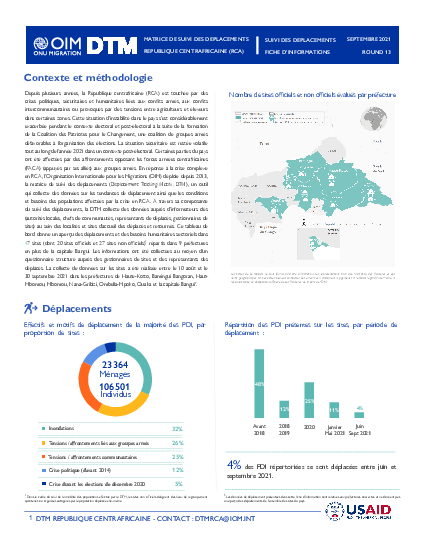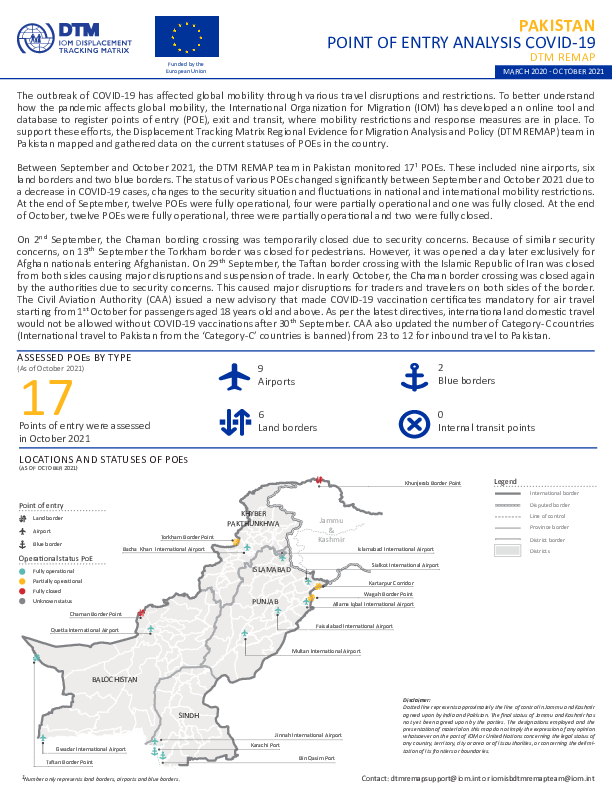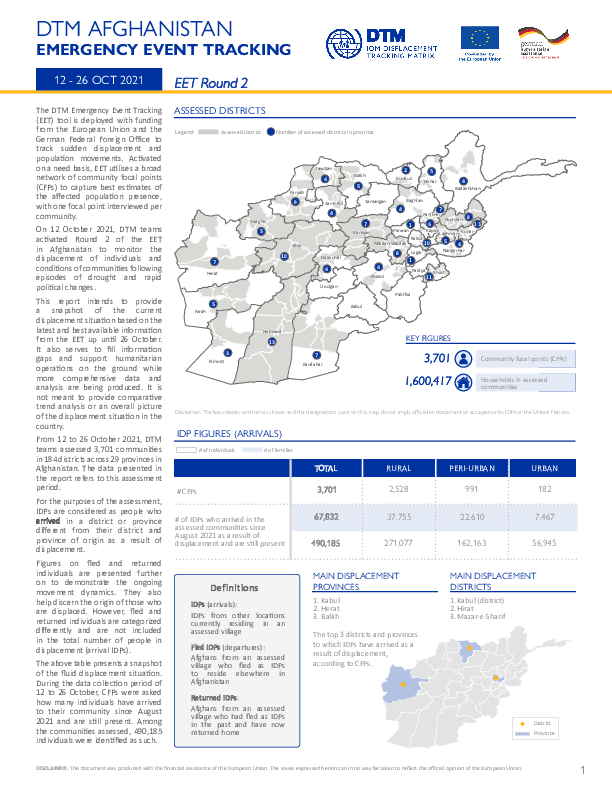-
Countries
-
Data and Analysis
-
Special Focus
-
Crisis Responses

Contact
DTM Central African Republic, DTMRCA@iom.int
Language
English
Location
Central African Republic
Period Covered
Aug 10 2021
Sep 30 2021
Activity
- Site Assessment
- Mobility Tracking
For several years, the Central African Republic (CAR) has been affected by political, security and humanitarian crises linked to armed conflicts, inter-community conflicts or caused by tensions between farmers and herders in certain areas. This unstable situation in the country was considerably exacerbated during the electoral and postelectoral context following the formation of the Coalition of Patriots for Change, a coalition of armed groups opposed to the organization of the elections. The security
situation remained volatile throughout 2021 in a post-election context. Parts of the country have been affected by clashes between the Central African Armed Forces (FACA) (supported by its allies) and armed groups. In response to the complex crisis in CAR, since 2013 the International Organization for Migration (IOM) has been deploying the Displacement Tracking Matrix (DTM), a tool that collects data on displacement trends as well as the conditions and needs of the populations affected by the crisis in the CAR. Through its displacement monitoring component, the DTM collects data from key informants (local authorities, community leaders, representatives of displaced persons, site managers) within the localities and sites hosted displaced and returnees.
This factsheet provides an overview of displacement and sectoral humanitarian needs in 47 sites (including 20 official sites and 27 unofficial sites)1. These sites are spread over 9 prefectures in addition to the capital Bangui. Information was collected through a structured questionnaire from site managers and representatives of the displaced. Data collection on the sites was carried out between August 10 and September 30, 2021 in the prefectures of Haute-Kotto, Bamingui Bangoran, Haut-Mbomou, Mbomou, Nana-Gribizi, Ombella-Mpoko, Ouaka et la capitale Bangui
La région du Sahel central, et plus particulièrement la zone du Liptako Gourma, qui enjambe le Burkina Faso, le Mali et le Niger, est témoin d’une crise complexe qui comprend comme enjeux une compétition grandissante pour le contrôle de ressources; des bouleversements climatiques; une croissance démographique galopante; des niveaux élevés de pauvreté; l’absence d’opportunités économiques et un sentiment de désillusions quant au futur; des tensions communautaires; l’absence de présence étatique et le manque de services sociaux de base; et des violences provoquées par des réseaux de crime organisé et des groups armés non étatiques. La crise a engendré, en 2020, la mort de 5 000 personnes 2020 (au 31 août) et conduit à des déplacements de populations significatifs dans les quatre pays touches par la crise. Au 31 oct 2021, 2 136 818 individus étaient déplacés par la crise, y compris 1 948 254 Personnes déplacées internes (91% de la population affectée) et 188 049 réfugiés (9%). Soixante-sept pour cent de la population déplacée (1 430 019 personnes) se trouvaient au Burkina Faso, 199 pour cent au Mali (414 922), 10 pour cent au Niger (216 818) et 3 pour cent en Mauritanie
(74 544).
The Central Sahel area, and in particular the Liptako Gourma region, which borders Burkina Faso, Mali and Niger, is affected by a complex crisis involving growing competition over dwindling resources; climatic variability; demographic pressure; high levels of poverty; disaffection and a lack of livelihood opportunities; communal tensions; the absence of state institutions and basic services; and violence related to organized crime and Non-State Armed Groups. The crisis has led to the death of an estimated 5,000 people in 2020 (as of 31 August) and triggered significant displacement of populations in the four affected countries. As of 31 October 2021, 2,136,303 individuals have been displaced, including 1,948,254 Internally Displaced Persons (91% of the displaced population) and 188,049 Refugees (9% of the displaced population). Sixty-seven per cent of the displaced population (1,430,019 individuals) were located in Burkina Faso, while 19 per cent resided in Mali (414,922 individuals), 10 per cent in Niger (216,818 individuals) and 3 per cent in Mauritania (74,544 individuals).
La crise dans le Bassin du lac Tchad est le résultat d’une combinaison complexe d’une multitude de facteurs, y compris un conflit armé impliquant des groups armés non étatiques, des niveaux extrêmes de pauvreté, un sous-développement persistent, et des bouleversements climatiques, qui ont conduit à des déplacements de populations importants. Au 31 octobre 2021, le Cameroun, le Tchad, le Nigeria et le Niger accueillaient 5 417 841 individus affectés par la crise, dont des Personnes déplacées internes (PDI), des réfugiés et des retournés (anciennes PDI et retournés de l’étranger). 76 pour cent d’entre eux (soit 4 100 676 personnes) se trouvaient au Nigéria, 11 pour cent au Cameroun (607 520 personnes), 9 pour cent au Tchad (476 548 personnes) et 4 pour cent au Niger (233 097 personnes).
The crisis currently affecting the Lake Chad Basin states results from a complex combination of factors, including conflict with Non-State Armed Groups, extreme poverty, underdevelopment and a changing climate, which together have triggered significant displacement of populations. As of 31 October 2021, Cameroon, Chad, Niger and Nigeria were hosting an estimated 5,417,841 affected individuals made up of Internally Displaced Persons (IDPs), Refugees (both in- and out-of-camp), Returnees (Former IDPs and Returnees from abroad) and Third Country Nationals (TCNs). 76 per cent of the affected population (representing 4,100,676 individuals) were located in Nigeria, while 11 per cent resided in Cameroon (607,520 individuals), 9 per cent in Chad (476,548 individuals) and 4 per cent in Niger (233,097 individuals).

Contact
DTM Central African Republic, DTMRCA@iom.int
Language
French
Location
Central African Republic
Period Covered
Sep 01 2021
Sep 30 2021
Activity
- Site Assessment
- Mobility Tracking
Depuis plusieurs années, la République centrafricaine (RCA) est touchée par des crises politiques, sécuritaires et humanitaires liées aux conflits armés, aux conflits intercommunautaires ou provoqués par des tensions entre agriculteurs et éleveurs dans certaines zones. Cette situation d’instabilité dans le pays s’est considérablement exacerbée pendant le contexte électoral et post-électoral à la suite de la formation de la Coalition des Patriotes pour le Changement, une coalition de groupes armés défavorables à l’organisation des élections. La situation sécuritaire est restée volatile tout au long de l’année 2021 dans un contexte post-électoral. Certaines parties du pays ont été affectées par des affrontements opposant les forces armées centrafricaines (FACA) (appuyés par ses alliés) aux groupes armés. En réponse à la crise complexe en RCA, l’Organisation Internationale pour les Migrations (OIM) déploie depuis 2013, la matrice de suivi des déplacements (Displacement Tracking Matrix, DTM), un outil qui collecte des données sur les tendances de déplacement ainsi que les conditions et besoins des populations affectées par la crise en RCA. A travers sa composante du suivi des déplacements, la DTM collecte des données auprès d’informateurs clés (autorités locales, chefs de communautés, représentants de déplacés, gestionnaires de sites) au sein des localités et sites d’accueil des déplacés et retournés. Ce tableau de bord donne un aperçu des déplacements et des besoins humanitaires sectoriels dans 47 sites (dont 20 sites officiels et 27 sites non officiels) répartis dans 9 préfectures en plus de la capitale Bangui. Les informations ont été collectées au moyen d’un questionnaire structuré auprès des gestionnaires de sites et des représentants des déplacés. La collecte de données sur les sites a été réalisée entre le 10 août et le 30 septembre 2021 dans les préfectures de Haute-Kotto, Bamingui Bangoran, Haut-Mbomou, Mbomou, Nana-Gribizi, Ombella-Mpoko, Ouaka et la capitale Bangui

Contact
DTM CAR, DTMRCA@iom.int
Language
French
Location
Central African Republic
Period Covered
Aug 01 2021
Sep 30 2021
Activity
- Mobility Tracking
- Baseline Assessment
Depuis plusieurs années, la République centrafricaine (RCA) est touchée par des crises politiques, sécuritaires et humanitaires liées aux conflits armés, aux conflits intercommunautaires ou provoquées par des conflits entre agriculteurs et éleveurs dans certaines zones. Cette situation d’instabilité dans le pays s’est considérablement exacerbée pendant le contexte électoral et post-électoral à la suite de la formation de la Coalition des Patriotes pour le Changement (CPC), une coalition de groupes armés défavorables à l’organisation des élections présidentielles de fin 2020 / début 2021. La situation
sécuritaire est restée volatile tout au long de l’année 2021. Certaines parties du pays ont été affectées par des attaques de groupes armés et d’autres ont souffert des affrontements opposant les Forces Armées centrafricaines (FACA) (appuyée par ses alliés) aux groupes armés. De surcroît, les pluies diluviennes causant des inondations pendant la période hivernale accroissent la vulnérabilité des populations en engendrant le déplacement de milliers de personnes.

Contact
DTM CAR, DTMRCA@iom.int
Language
French
Location
Central African Republic
Period Covered
Aug 01 2021
Sep 30 2021
Activity
- Mobility Tracking
- Baseline Assessment
Ce rapport fournit un aperçu de la situation de déplacement et des besoins humanitaires multisectoriels dans les localités accueillant les populations mobiles en République centrafricaine (RCA), ayant effectué soit des mouvements de déplacement forcés, soit des mouvements de retour vers leurs zones de provenance. L’évaluation a été réalisée par l’Organisation Internationale pour les Migrations (OIM) entre le 10 Août et le 30 Septembre 2021 dans 1 854 localités
d’accueil des populations déplacées internes (PDI) et / ou retournées et 47 sites d’accueil des PDI. Les données ont été collectées auprès d’informateurs clés incluant des représentants de déplacés, chefs de communautés, gestionnaires de sites, membres d’associations.

Contact
iomisbdtmremapteam@iom.int
Language
English
Location
Pakistan
Period Covered
Mar 17 2020
Oct 31 2021
Activity
- Points of Entry (PoE)
The outbreak of COVID-19 has affected global mobility through various travel disruptions and restrictions. To better understand how the pandemic affects global mobility, the International Organization for Migration (IOM) has developed an online tool and database to register points of entry (POE), exit and transit, where mobility restrictions and response measures are in place. To support these efforts, the Displacement Tracking Matrix Regional Evidence for Migration Analysis and Policy (DTM REMAP) team in Pakistan mapped and gathered data on the current statuses of POEs in the country.
Between September and October 2021, the DTM REMAP team in Pakistan monitored 17¹ POEs. These included nine airports, six land borders and two blue borders. The status of various POEs changed significantly between September and October 2021 due to a decrease in COVID-19 cases, changes to the security situation and fluctuations in national and international mobility restrictions. At the end of September, twelve POEs were fully operational, four were partially operational and one was fully closed. At the end of October, twelve POEs were fully operational, three were partially operational and two were fully closed.
On 2nd September, the Chaman bording crossing was temporarily closed due to security concerns. Because of similar security concerns, on 13th September the Torkham border was closed for pedestrians. However, it was opened a day later exclusively for Afghan nationals entering Afghanistan. On 29th September, the Taftan border crossing with the Islamic Republic of Iran was closed from both sides causing major disruptions and suspension of trade. In early October, the Chaman border crossing was closed again by the authorities due to security concerns. This caused major disruptions for traders and travelers on both sides of the border. The Civil Aviation Authority (CAA) issued a new advisory that made COVID-19 vaccination certificates mandatory for air travel starting from 1st October for passengers aged 18 years old and above. As per the latest directives, international and domestic travel would not be allowed without COVID-19 vaccinations after 30th September. CAA also updated the number of Category-C countries (International travel to Pakistan from the ‘Category-C’ countries is banned) from 23 to 12 for inbound travel to Pakistan.

Contact
DTM Afghanistan, DTMKabul@iom.int
Language
English
Location
Afghanistan
Period Covered
Oct 12 2021
Oct 26 2021
Activity
- Event Tracking
The DTM Emergency Event Tracking (EET) tool is deployed with funding from the European Union and the German Federal Foreign Office to track sudden displacement and population movements. Activated on a need basis, EET utilises a broad network of community focal points (CFPs) to capture best estimates of the affected population presence, with one focal point interviewed per community.
On 12 October 2021, DTM teams activated Round 2 of the EET in Afghanistan to monitor the displacement of individuals and conditions of communities following episodes of drought and rapid political changes.
This report intends to provide a snapshot of the current displacement situation based on the latest and best available information from the EET up until 26 October. It also serves to fill information gaps and support humanitarian operations on the ground while more comprehensive data and analysis are being produced. It is not meant to provide comparative trend analysis or an overall picture of the displacement situation in the country.
From 12 to 26 October 2021, DTM teams assessed 3,701 communities in 184 districts across 29 provinces in Afghanistan. The data presented in the report refers to this assessment period.




